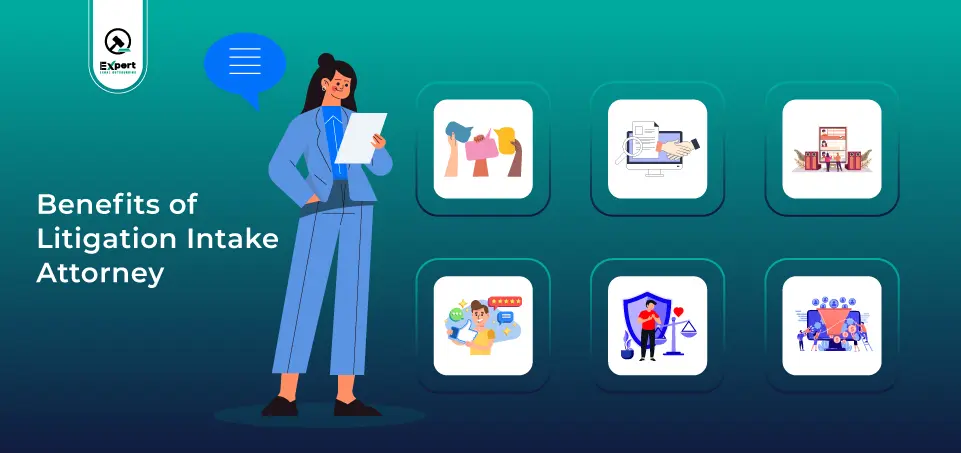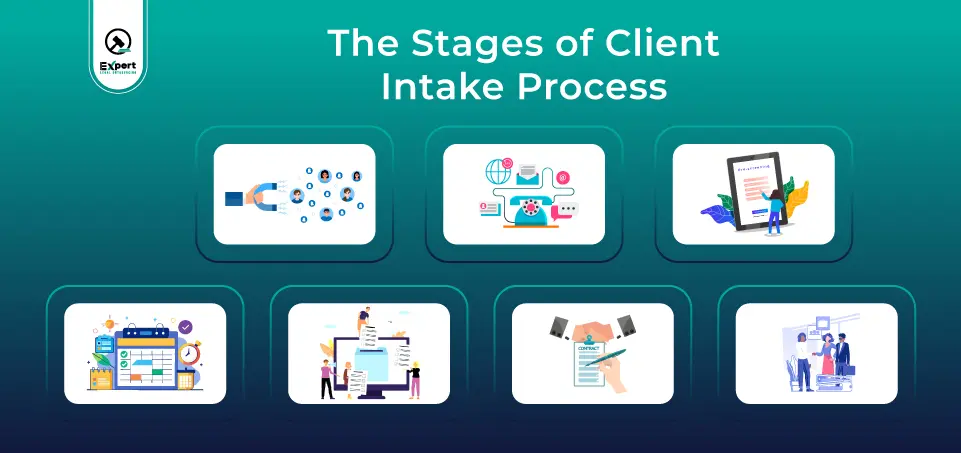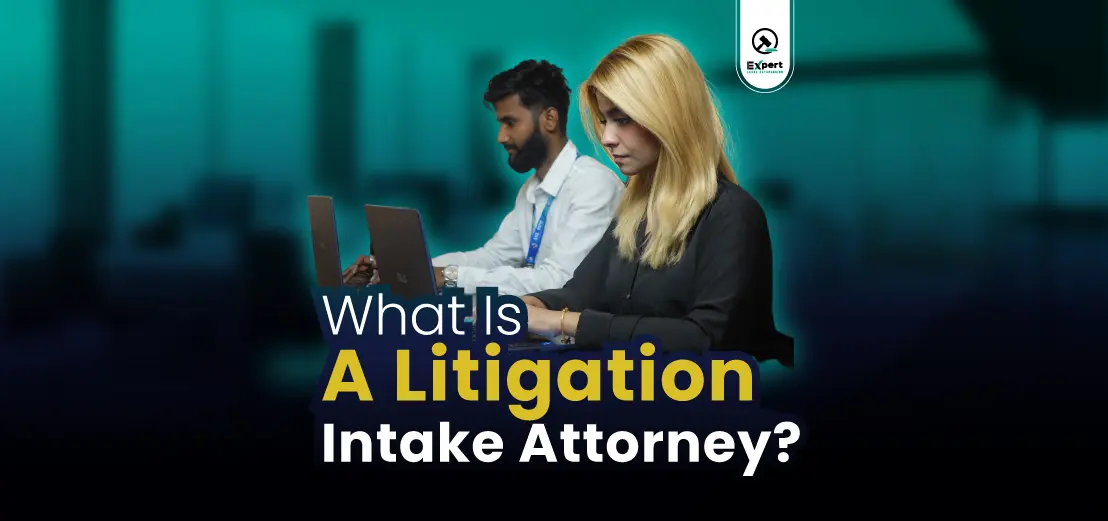We are here to talk about how to turn potential leads into long-term clients and to do that we need a litigation intake attorney.
But, What is a Litigation Intake Attorney?
Litigation is the process of taking a legal action.
Legal intake process is how a business or law firm assesses a potential client, case, project, or legal request to determine if there are any red flags. Yes, you can outsource litigation support, but learning on Legal intake process is equally important. For this, we need a legal case intake attorney.
Understanding Litigation Intake Attorneys
Litigation attorney or a litigator presents evidence, examine witnesses, and argue in favor of their client’s case.
Lawyers, on the other hand, are professionals who provide legal advice, draft legal documents, and represent clients on many types of legal issues.
While litigators often specialize in trial work, lawyers can practice in many different areas of law, such as corporate law, tax law, and real estate law.
The Importance of Legal Intake

You cannot ignore the client intake process, as it might create a black hole for your firm.
Even with the strongest and most well-trained lawyers, your firm will be inoperative if you are unable to effectively onboard new clients. An unsteady and broken workflow will let leads slip out of your hand.
This is where the Litigation Intake Attorney walks in.
The legal intake specialist plays a pivotal role in the success of any law firm. This often overlooked position acts as the first line of defense, ensuring that potential clients are properly screened, informed, and guided through the legal process.
Benefits of Working with a Litigation Intake Attorney

- Expertise in Client Communication
For example, if a law firm were a cake, then intake specialists would be the flour.
Why you might ask? In fact, it is because they effectively communicate with potential clients. They listen attentively, offer empathy, and build rapport, which helps clients feel comfortable and trust the law firm.
This strong communication is key to understanding client needs, converting leads, and building lasting relationships.
- Efficient Screening and Qualification
Screening potential clients is important to a law firm.
At this point, the attorney asks important questions to determine if a case is a good fit for the firm’s expertise. This saves the firm time and resources by focusing on cases with a higher chance of success.
- Improved Client Intake Process
A smooth client intake process plays a role in the success of a law firm.
Intake attorneys are there to improve the process for you. They handle administrative tasks like gathering documents, scheduling appointments, and organizing client information. As a result, this streamlines the intake process, ensures accurate information, and provides a better overall client experience.
- Enhanced Client Satisfaction
Satisfied clients contribute to the reputation of the law firm.
To achieve this, an intake attorney might be required to provide customized services. They will have to promptly, listen carefully, and address client concerns effectively. This will create a ground for loyal clients, repeat business, referrals, and positive reviews.
A good face will ensure an increase in leads which guarantees the growth of the firm.
- Focus on Core Legal Work
Hiring an intake attorney creates an opportunity for you to focus on your firm’s core competencies. They take over the duty of handling the initial client interaction.
With their help, other attorneys get to focus on tasks such as legal research, case preparation, and client representation. The overall set up will improve efficiency, ensure high-quality legal services, and help your law firm maximize resources and deliver exceptional outcomes.
- Increased Conversion Rates
Implementing an effective intake management process will boost your law firm’s conversion rates. By asking the right questions and gathering crucial information, they can assess a case’s potential value and determine if it’s a good fit for your firm.
Intake attorneys are well-versed in communicating with potential clients, this will benefit your firm and promises good relationship between current and future clients.
With a dedicated intake specialist, your firm can refine its marketing strategies and attract more qualified clients. This can lead to increased revenue and overall growth.
Legal Client Intake Process: The Guide
Now that you have skimmed through the detailed benefits of hiring a litigation intake attorney, here is an efficient guide to the legal client intake process.

Attracting A New Potential Client
The first phase of the process is collecting clients. For this, you can utilize search engine optimization (SEO), social media, and content marketing to increase your online visibility and reach potential clients.
Attending industry events, connecting with local businesses, and building relationships within your community will help you generate referrals.
Lastly, having a user-friendly website, informative and showcases your expertise in relevant legal areas will catch the eyes of potential clients.
Capturing Contact Information
Making it easy for potential clients to share their contact information with you is key to earning them as a client. A prominent way to encourage clients to contact you is by using strong, persuasive language.
You could also consider providing free consultations or informational resources in exchange for contact information. Offering incentives has been a traditional way of attracting customers for a good time.
Since, the digital world is taking over, another way to collect information would using Contact Forms. Visitor will be able to submit their data through a simple online form.
Pre-screening
Before booking an initial consultation, collect enough information to determine whether a given client is a fit for your firm. You can gather initial information about the potential client by phone or email inquiries. You need to clarify what their legals needs are and determine if they are a good fit for your firm.
Assess the level of complexity of the case, the potential value, and the likelihood of a successful outcome. Keep in mind, you must check for any conflicts of interest that may prevent you from representing the client.
Conflict Checking
Make sure there’s no reason you can’t work for a potential client. Install specialized softwares to efficiently identify and manage potential conflicts of interest. It is your duty to double-check your existing client database and ensure that there are no conflicts occurring.
A through research on the potential client’s background and any related legal matters is mandatory. So, that nothing is news to your ears.
Scheduling and Holding An Initial Consultation
To hold an initial consultation, you will need to schedule a meeting. It is best to allow clients an option to choose from the time they would like to sit and how they would like the interview to be (in-person, phone, or video).
The best way to get on with this is by using latest online scheduling software to streamline the appointment booking process. At the initial interview session, develop a structured approach to the initial consultation, covering key topics and addressing potential questions.
Collecting Key Information Via An Intake Questionnaire
When creating the Intake form, include questions that gather essential details about the client’s case, legal history, and contact information. Try to avoid legal jargon and make the questionnaire easy to understand. Without thinking twice, outsourcing legal research would take some of the stress off of you. You have to make sure you clearly explain how to complete the questionnaire and where to submit it.
Creating a fee agreement—and getting it signed.
With the right tools, you can generate this form automatically from information in the client’s intake questionnaire.
For example, purchase a legal practice management software to generate fee agreements based on the information collected in the intake questionnaire. Ensure the fee agreement accurately reflects the terms of the engagement and is tailored to the specific client’s needs.
Before proceeding with the representation, both parties need to sign the fees agreement.
New client onboarding
Law firm client onboarding should begin with clear communication of your firm’s policies, procedures, and billing practices to the client. This should include providing clients with relevant information, such as contact details, office hours, and billing instructions.
Lastly, build trust and rapport with the client to ensure a positive and successful legal experience.
Client Intake Best Practices
1. Document your client intake policies and processes
Clearly outline your firm’s procedures for handling inquiries, scheduling consultations, and collecting client information. This ensures consistency and efficiency among your staff. To ensure that all your firm’s procedures are top-notch you can outsource legal document reviews services.
2. Conduct a thoughtful pre-screen
Use a brief phone call or email inquiry to assess a potential client’s case and determine if it aligns with your firm’s expertise and resources. It is OK to say no to those who would be better served elsewhere. It is not possible to be able to solve every and each problem. This saves time and helps avoid taking on cases that are not a good fit.
3. Listen actively during your initial consult
To establish a connection with potential customers, demonstrate understanding and empathy. To get useful information, concentrate on their wants and requirements while posing open-ended inquiries.
4. Discuss fees clearly and openly
Be transparent about your billing practices, payment options, and any potential costs. This helps set expectations and avoids misunderstandings. Never be hesitant to bring up other pricing options, such as offering payment plans or charging flat costs rather than on an hourly basis.
5. Integrate with your practice management software
In addition to being error-prone, duplicate data entering can be time-consuming. Streamline your intake process by automating data entry and reducing manual work. This minimizes errors and saves time.
6. Track potential clients by their stage in the law firm intake process
Avoid letting prospective customers slip through the gaps.
Use a system to track the progress of potential clients through your intake process. For a clear picture of which clients you need to take action on—and what needs to happen—divide your law firm intake process into distinct stages, such as “not yet contacted,” “needs follow-up,” or “intake form pending.”
This ensures that no leads are overlooked and helps you prioritize follow-ups.
7. Automate engagement agreements
Use document automation software to create standardized agreements and populate them with client-specific information, saving time and reducing errors.
8. Offer e-signatures
Your objective should always be to reduce obstacles while acquiring new customers. Provide a convenient and efficient way for clients to sign agreements electronically, reducing paperwork and speeding up the intake process.
9. Never stop improving
It’s crucial to remember that no matter how much you progress, your customer intake procedure will never be flawless. Thus, regularly review and evaluate your client intake process to identify areas for improvement and ensure that it remains efficient and effective.
Finding the Right Litigation Intake Attorney

Finding the lawyer for you can be a challenge if you don’t know where to look. For example, if you are settled in California and ideal option would be search up The State Bar of California where you will find a big list of resources to help you find what you need
However, if you are still struggling and don’t have the time to search up a lawyer for yourself, my wisest advise would be follow up with Legal Process Outsourcing (LPO) companies and hire a virtual attorney. LPO companies for a fract provide various legal process outsourcing services which helps find a solution from home.
What to Expect from the Initial Consultation
Before meeting with your attorneys, make a list of questions and identify the main objective for the meeting. Gather all the documents related to your case and bring them to your meeting. Showing up prepared allows the consultation to run smoothly.
So, during the initial meeting, honestly and accuracy matters in the case of answer questions about your case. Inaccurate or incomplete details can lead to a less effective strategy.
Asking questions if unclear is a part of understanding everything so you must asks question if any term goes over your head. Before the meeting ends, ensure you are clear about the following:
- Potential Legal Options – “While we can’t provide legal advice until you’re a client, we can discuss possible avenues.”
- Potential Challenges – Understand the potential difficulties or complications your case might face.
- Timeline – Get an estimate of how long the case might take.
- Costs and Payment Plans – Discuss the estimated fees and available payment options.
- Required Documentation – Know what documents you’ll need to provide.
- Next Steps – Understand the steps involved in opening a case with our firm.
Fees Structure of Litigation Intake Attorneys
Different firms have their own way of billing their services. Thus, your firm needs to charge any expenses or costs incurred on behalf of the clients, unless there is a specific agreement in place that states otherwise.
They have four Fees structures and each type of structure comes with degree of risk for the firm. Here is a quick summary of the types of Fees structure:
| Fees Structure | Risk | Mitigation Strategies |
| Fixed Fees | Spending more on representation than earned. | Monitor case profitability, adjust fixed-fee schedule. |
| Contingency Fees | Costs without revenue. | Conservative case selection, require upfront cost payments. |
| Retainer Fees | Case costs exceeding client expectations. | Clear communication, reputation management. |
| Hourly Fees | Non-payment risks, inability to withdraw. | Strong client communication, contingency for non-payment. |
Another aspect to keep in mind is when clients promptly pay their invoices, it benefits your firm as a healthy cash flow is being maintained. Moreover, offering clients a variety of payment options can significantly improve collection rates.
Here are popular payment methods for law firms:
Credit and Debit Cards
| Benefits | Faster depositsReduced risk of check fraud. |
| Challenges | Trust Accounting rules can be complex with standard merchant accounts. |
| Solution | Specialized legal payment solutions like LawPay can handle trust accounting complexities and simplify card processing. |
ACH Payments
It is similar to eChecks where clients provide bank account information for direct transfers.
- Advantages: Faster settlement, lower processing fees compared to credit cards.
PayPal
It is an online payment system that allows clients to pay without sharing card details.
- Considerations: Carefully review processing fees and state regulations.
Payment Plans
| Benefits for Clients | Easier budgetingManageable payments. |
| Benefits for Firms | Predictable Cash Flow |
| Customization | Tailor payment plans to individual client needs. |
Conclusion
So, now you know that hiring a Litigation Intake Attorney is more than just a smart business move—it’s an investment in the long-term success and reputation of your law firm. From improving your client intake process to enhancing communication and ensuring higher conversion rates, the right intake attorney can make all the difference.
By screening potential clients efficiently, and handling initial consultations, intake attorneys allow your firm to focus on what truly matters—delivering exceptional legal services. When you prioritize a well-structured intake process, you build stronger relationships, improve client satisfaction, and ultimately position your firm for sustainable growth.
Whether you’re a seasoned law firm looking to enhance your operations or a startup ready to hit the ground running, a litigation intake attorney could be the key to unlocking new opportunities and taking your firm to the next level.
Ready to optimize your legal intake process? It’s time to empower your law firm with the right tools and talent—starting with a litigation intake attorney.
Frequently Asked Questions
[sp_easyaccordion id=”27457″]

Rafia Alam Rowshni delivers a unique combination of legal knowledge and content creation talent using SEO Tools and SERP analysis. She has a solid background in public health and legal services and knows the complexities of the legal world. She can translate complex subjects into simple, concise, and entertaining information that audiences can actually use.




